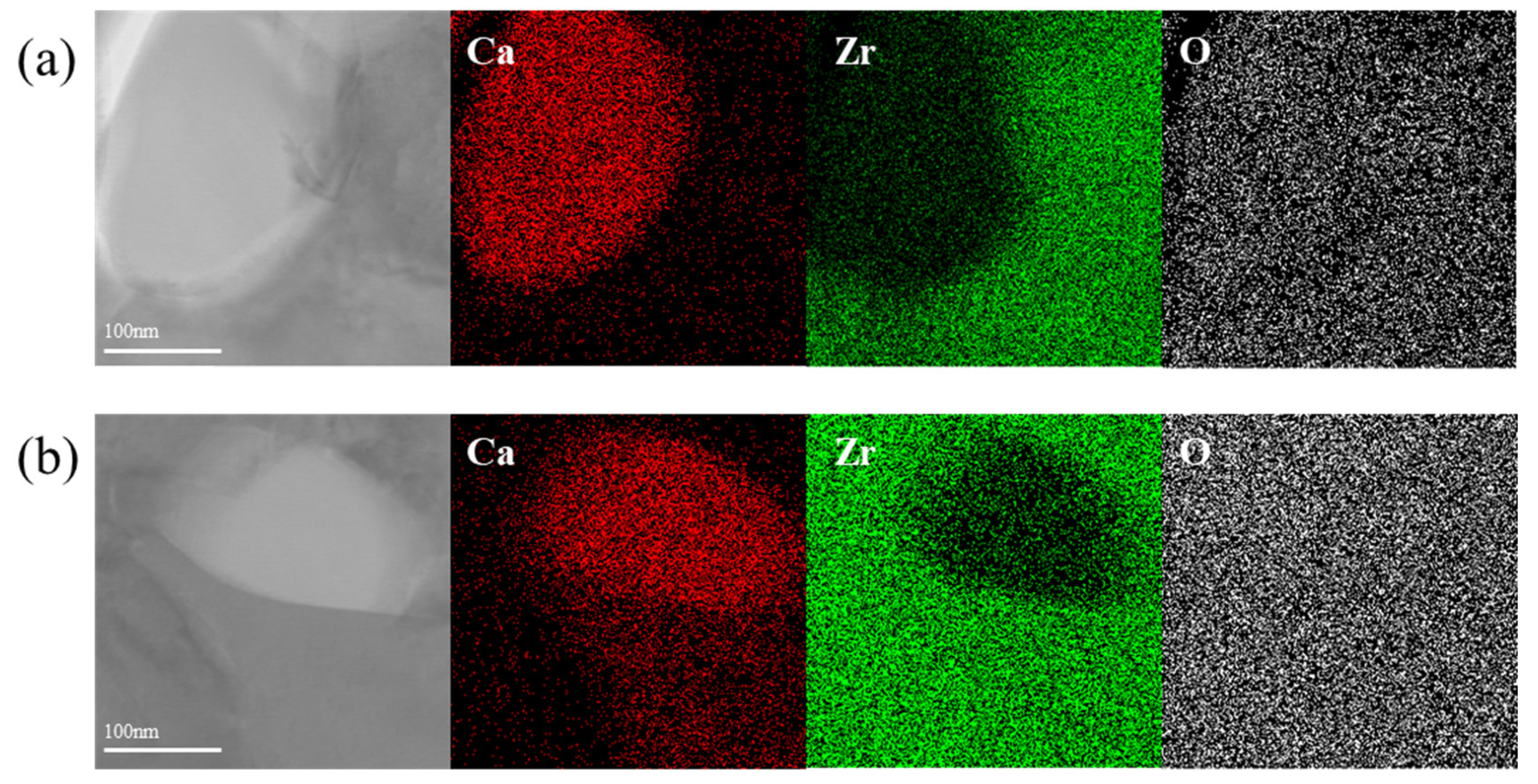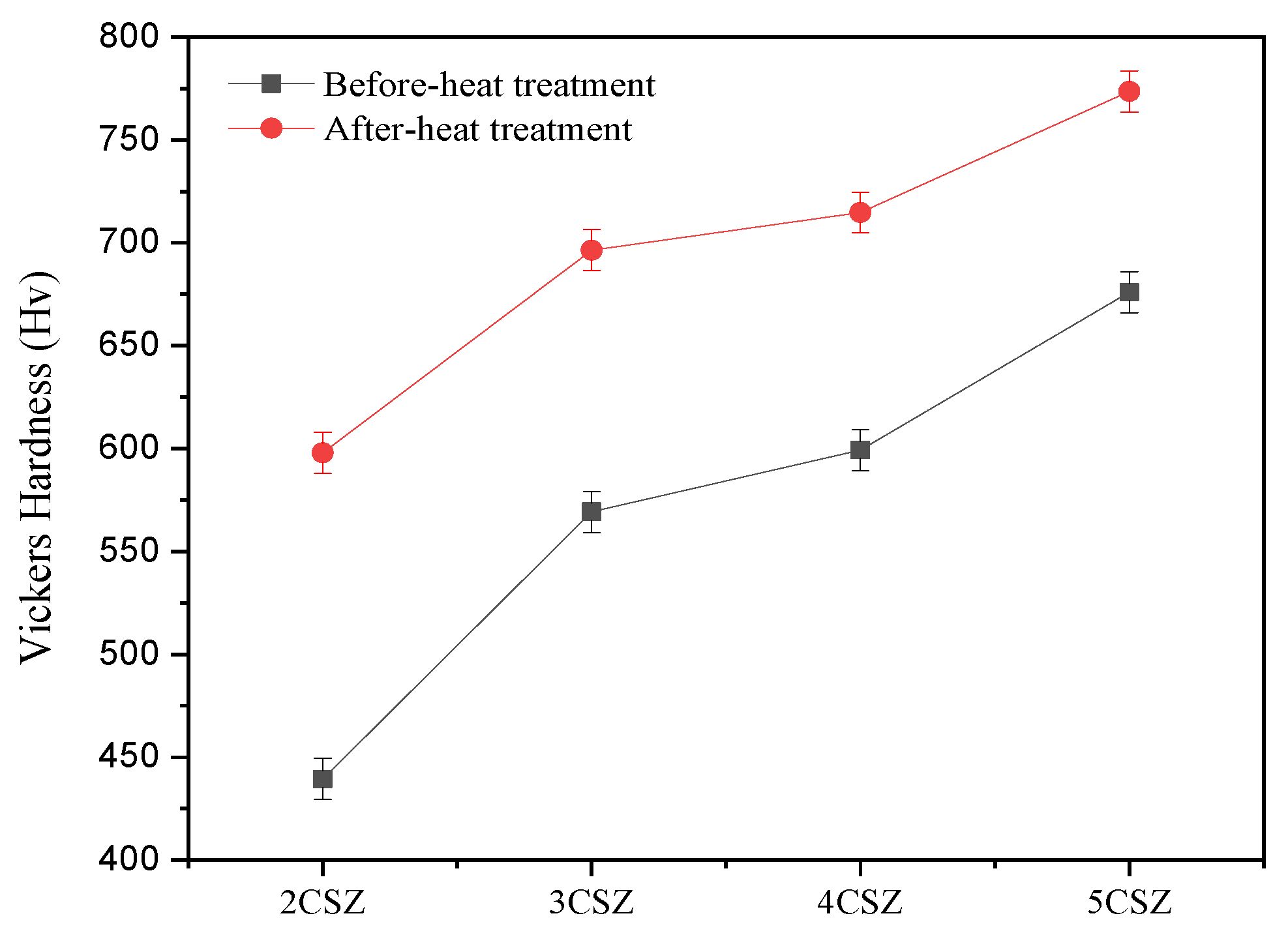Phase Formation and Stabilization Behavior of Ca-PSZ by Post-Heat Treatment
Abstract
1. Introduction
2. Experimental
3. Results and Discussion
4. Conclusions
Author Contributions
Funding
Institutional Review Board Statement
Informed Consent Statement
Data Availability Statement
Conflicts of Interest
References
- Suk, M.O.; Park, J.H. Corrosion behaviors of zirconia refractory by CaO–SiO2–MgO–CaF2 slag. J. Am. Ceram. Soc. 2009, 92, 717–723. [Google Scholar] [CrossRef]
- López-Gándara, C.; Ramos, F.M.; Cirera, A. YSZ-based oxygen sensors and the use of nanomaterials: A review from classical models to current trends. J. Sens. 2009, 2009, 258489. [Google Scholar] [CrossRef]
- Badwal, S.P.S.; Foger, K. Solid oxide electrolyte fuel cell review. Ceram. Int. 1996, 22, 257–265. [Google Scholar] [CrossRef]
- Yang, S.K.; Jung, J.Y.; Kang, J.B. Characteristics of Sintered Yttria Stabilized Tetragonal Zirconia Polycrystals (3Y-TZP) with Alumina. J. Korean Ceram. Soc. 2004, 41, 601–608. (In Korean) [Google Scholar] [CrossRef]
- Kang, D.S.; Kim, M.I.; Park, J.H.; Moon, S.W.; Baek, S.S. A Study on the Ceria Stabilized Tetragonal Zirconia Polycrystals(Ce-TZP) (II): Mechanical Properties of Ce-TZP and its Fracture Behavior at Elevated Temperature. J. Korean Ceram. Soc. 1989, 26, 789–794. [Google Scholar]
- Fan, Z.; Chao, C.C.; Hossein-Babaei, F.; Prinz, F.B. Improving solid oxide fuel cells with yttria-doped ceria interlayers by atomic layer deposition. J. Mater. Chem. 2011, 21, 10903–10906. [Google Scholar] [CrossRef]
- Wang, S.; Zhai, Y.; Li, X.; Li, Y.; Wang, K. Coprecipitation Synthesis of MgO-Doped ZrO2 Nano Powder. J. Am. Ceram. Soc. 2006, 89, 3577–3581. [Google Scholar] [CrossRef]
- Farhikhteh, S.; Maghsoudipour, A.; Raissi, B. Synthesis of nanocrystalline YSZ (ZrO2–8Y2O3) powder by polymerized complex method. J. Alloys Compd. 2010, 491, 402–405. [Google Scholar] [CrossRef]
- Zhao, L.; Yao, S.; Kang, L.; Sun, H.Y.; Huang, Q. Corrosion Mechanism of Calcium Oxide Partially Stabilized Zirconia by an Alkaline Metallurgical Slag. Sci. Adv. Mater. 2019, 11, 483–488. [Google Scholar] [CrossRef]
- Hwanseok, L.; Kanghee, J.; Heesoo, L. Phase stability of yttria-stabilized zirconia under thermo-chemical stress for solid oxide membrane electrolysis. J. Surf. Sci. Eng. 2021, 6, 38. [Google Scholar]
- Peirani, M.V.; Brandaleze, E. Corrosion mechanisms caused on a submerged nozzle applied in steel billet production by mold fluxes with and without fluorine. Sch. J. Eng. Technol. 2017, 5, 280–289. [Google Scholar] [CrossRef]
- Sung, Y.T.; Son, J.H.; Lee, S.S.; Bae, D.S. Study on the Corrosion Characteristics in the Slag Line of SEN Oxide Refractory. Korean J. Mater. Res. 2014, 24, 53–59. [Google Scholar] [CrossRef][Green Version]
- Jin, E.; Yuan, L.; Yu, J.; Ding, D.; Xiao, G. Enhancement of thermal shock and slag corrosion resistance of MgO–ZrO2 ceramics by doping CeO2. Ceram. Int. 2022, 48, 13987–13995. [Google Scholar] [CrossRef]
- Shah, K.; Holloway, J.A.; Denry, I.L. Effect of coloring with various metal oxides on the microstructure, color, and flexural strength of 3Y-TZP. J. Biomed. Mater. Res.-B Appl. Biomater. 2008, 87, 329–337. [Google Scholar] [CrossRef] [PubMed]
- Toraya, H.; Yoshimura, M.; Somiya, S. Calibration curve for quantitative analysis of the monoclinic-tetragonal ZrO2 system by X-ray diffraction. J. Am. Ceram. Soc. 1984, 67, C-119. [Google Scholar] [CrossRef]
- Hannink, R.H.; Kelly, P.M.; Muddle, B.C. Transformation toughening in zirconia-containing ceramics. J. Am. Ceram. Soc. 2000, 83, 461–487. [Google Scholar] [CrossRef]
- Hayashi, H.; Saitou, T.; Maruyama, N.; Inaba, H.; Kawamura, K.; Mori, M. Thermal expansion coefficient of yttria stabilized zirconia for various yttria contents. Solid State Ion. 2015, 176, 613–619. [Google Scholar] [CrossRef]
- Jung, J.H.; Yon, S.J.; Seok, J.W. Cubic zirconia single crystal growth using shell by skull melting method. J. Korean Cryst. Growth Cryst. Technol. 2013, 23, 124–128. [Google Scholar] [CrossRef]
- Park, J.H.; Bang, I.H.; Lee, S.J.; Park, J.H.; Bang, I.H.; Lee, S.J. Phase Transition and Thermal Expansion Behavior of Zirconia Setter Fabricated from Fused CaO Stabilized Zirconia. J. Korean Ceram. Soc. 2019, 56, 184–190. [Google Scholar] [CrossRef]





| Compound | Composition | |
|---|---|---|
| CaO Addition (Mol%) | ZrO2 (Mol%) | |
| 2CSZ | 2 | 98 |
| 3CSZ | 3 | 97 |
| 4CSZ | 4 | 96 |
| 5CSZ | 5 | 95 |
| Compound | Monoclinic Phase Volume Fraction (%) | |
|---|---|---|
| Before-Heat Treatment | After-Heat Treatment | |
| 2CSZ | 91.42 | 85.47 |
| 3CSZ | 84.42 | 71.70 |
| 4CSZ | 75.25 | 67.61 |
| 5CSZ | 62.50 | 59.38 |
| Compound | Thermal Expansion Coefficient (1/K) | |
|---|---|---|
| Before-Heat Treatment | After-Heat Treatment | |
| 2CSZ | 7.665 × 10−6 K−1 | 8.049 × 10−6 K−1 |
| 3CSZ | 7.763 × 10−6 K−1 | 8.092 × 10−6 K−1 |
| 4CSZ | 8.583 × 10−6 K−1 | 8.605 × 10−6 K−1 |
| 5CSZ | 8.811 × 10−6 K−1 | 8.916 × 10−6 K−1 |
Publisher’s Note: MDPI stays neutral with regard to jurisdictional claims in published maps and institutional affiliations. |
© 2022 by the authors. Licensee MDPI, Basel, Switzerland. This article is an open access article distributed under the terms and conditions of the Creative Commons Attribution (CC BY) license (https://creativecommons.org/licenses/by/4.0/).
Share and Cite
Yoo, H.; Lee, H.; Jo, K.; Kim, J.; Jo, I.; Lee, H. Phase Formation and Stabilization Behavior of Ca-PSZ by Post-Heat Treatment. Metals 2022, 12, 1479. https://doi.org/10.3390/met12091479
Yoo H, Lee H, Jo K, Kim J, Jo I, Lee H. Phase Formation and Stabilization Behavior of Ca-PSZ by Post-Heat Treatment. Metals. 2022; 12(9):1479. https://doi.org/10.3390/met12091479
Chicago/Turabian StyleYoo, Hyunjo, Hwanseok Lee, Kanghee Jo, Juyoung Kim, Ilguk Jo, and Heesoo Lee. 2022. "Phase Formation and Stabilization Behavior of Ca-PSZ by Post-Heat Treatment" Metals 12, no. 9: 1479. https://doi.org/10.3390/met12091479
APA StyleYoo, H., Lee, H., Jo, K., Kim, J., Jo, I., & Lee, H. (2022). Phase Formation and Stabilization Behavior of Ca-PSZ by Post-Heat Treatment. Metals, 12(9), 1479. https://doi.org/10.3390/met12091479








